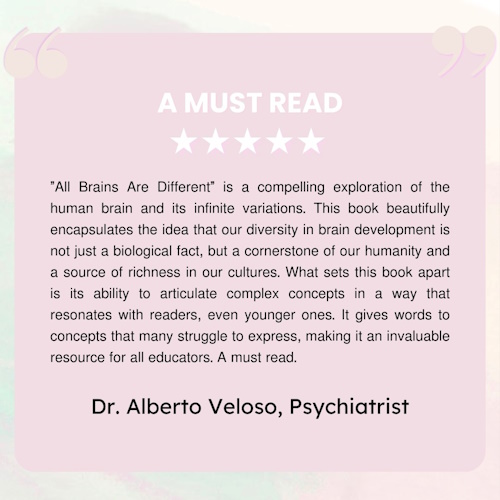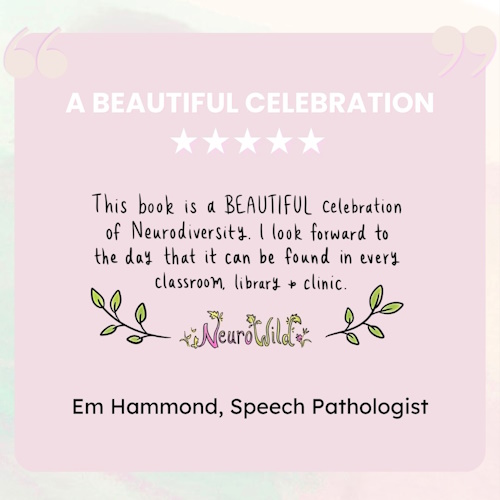All Brains Are Different
Learn about neurodiversity at school and home with 'All Brains Are Different'.
All Brains Are Different (ABAD) is an innovative program that introduces the concept of neurodiversity in an affirming way to your students, their families and teachers.
Key components of the ABAD program:
- Childrens Book: "All Brains Are Different" offers a vibrant, engaging introduction to neurodiversity, designed for young minds, their teachers and families.
- Teacher's Guide: The accompanying guide provides educators with practical tools, lesson plans, and activities to implement the principles of neurodiversity, ensuring that students of all backgrounds are supported and valued for their unique abilities.
- Ongoing Development: This program is dynamic and evolving. Stay tuned for additional resources and developments that will continue to enrich and expand our understanding of neurodiversity.
Developed with the support of the Department of Education and crafted by Yellow Ladybugs, this initiative encourages teachers everywhere to introduce neurodiversity into their classrooms and apply key affirming strategies at a whole school level.
The goal of ABAD is to help you:
- Understand: Enhance understanding of neurodiversity terms and concepts.
- Reflect: Cultivate a more positive mindset towards neurodiversity and neurodivergence.
- Act: Promote a proactive and inclusive culture within the school community.
ABAD has been designed to seamlessly integrate into the Victorian Education Department's Respectful Relationships curriculum, however, its universal principles make it an invaluable resource for educators and families worldwide.
This program isn't just for schools—it's also designed for families, therapists; and the entire community seeking to broaden their diversity education at home, similar to books on cultural or racial diversity. "All Brains Are Different" helps children and adults alike appreciate the unique differences in how our brains work.
All Brains Are Different — Children's Book
Our brand new children's book welcomes you into our classroom, where diversity in brain types is accepted and supported as naturally as any other kind of diversity. This book opens up a world where every child's unique way of seeing the world is not just accepted but valued. From the very beginning, we introduce the concept of neurodiversity, emphasising that it's perfectly fine for everyone to experience and learn about the world in their own ways.
Our story extends into everyday school activities, illustrating how lunchtime and playtime are thoughtfully designed to support all students, including those with hidden needs. As we walk through the school day, you'll see how small changes in the classroom, playground, and during lunchtime activities help everyone feel included and comfortable - without judgment and stigma. The book shares stories and illustrations that open up discussions about why some of us might feel anxious during loud playtimes or prefer quieter activities. It helps us understand and respect different food choices without judgement, showing how empathy and curiosity can build a more affirming school environment.
This engaging story hopes to spark numerous conversations about diversity, with a special focus on the beautiful variety of our brains.
Authored and illustrated by neurodivergent creators, this book draws on real-life experiences to provide a genuine and impactful perspective on embracing neurodiversity.
Our words and illustrations have been carefully crafted to be neuro-affirming and to showcase the power of inclusion and the positive opportunities that arise from providing environments that meet everyone's needs. In these pages, we choose not to name specific differences, not because we shy away from them, but because we want to ensure that the focus of the book is on all brain types. We have focused on the powerful message that all brains work differently. Our goal is to make uniqueness the norm and to normalise difference, encouraging a world where everyone is embraced for who they are. By reading and sharing this book, you join us in a larger movement for change, helping to create a more inclusive and understanding classroom, school, home and society.
All Brains are Different - Teacher Guide
This comprehensive teacher's guide is meticulously designed to complement our children's book "All Brains Are Different," providing educators with the tools to seamlessly integrate the message of neurodiversity into the curriculum from an early age. It includes lesson plans, discussion points, and activities that build upon existing diversity concepts within the curriculum, focusing on the uniqueness of each individual's brain.
Goals of the Guide:The guide aims to help educators create an inclusive environment that celebrates all forms of diversity—both visible and invisible. It encourages students to appreciate differences, fostering self-reflection, acceptance, and empathy.
What You Will Find in This Guide:
- Introduction to Neurodiversity Terms: Get familiar with key concepts and terminology related to neurodiversity.
- Benefits of Introducing Neurodiversity in the Classroom: Explore the positive impacts of neurodiversity education on students and learning environments.
- Tips for Creating a Neuro-Affirming Classroom and School Environment: Practical advice on adapting your teaching space to support diverse needs.
- Recommended Booklist: A curated list of books that complement lessons on neurodiversity.
- Lesson Plans and Activity Guides: Innovative and engaging activities including Diversity Walk, This is Me, Feelings Charades, Sensory Exploration, and more.
About the Authors
Yellow Ladybugs was founded by Katie Koullas, a Melbourne mum driven to make the world more accepting of all brains. Katie, who realised she was autistic just like her children — her own "yellow ladybugs" — started this initiative to celebrate neurodiversity.
Working together as an incredible and neurodiverse team, Yellow Ladybugs has reached thousands, educating families, teachers and communities about the beauty of brain diversity. This book is one of many projects aimed at building a welcoming world through education, advocacy and community engagement.
Special thanks go to the extraordinary team, who alongside Katie, are the brains and creative souls behind this book: Alisa Mlakar, who has used her insights and experiences as a neurodivergent writer to create this captivating narrative of inclusivity; Natasha Staheli, a dedicated changemaker with years of lived experience, who has helped make this book both authentic and empowering; and Trish Burton, a neurodivergent illustrator whose passion and attention to detail brings every page to vibrant life.
We would also like to extend our heartfelt gratitude to the Department of Education, Victoria, for their belief in the importance of this book, and their support in bringing it to life.


Disclaimer
This book is a work of fiction. Names, characters, places, and incidents are either the creation of the author's imagination or are used fictitiously. All rights reserved. No part of this publication may be reproduced, distributed, or transmitted in any form or by any means, electronic or mechanical, including photocopying, recording, or any information storage and retrieval system, without the prior permission of the publisher.
The content of this book is intended for informational purposes only and is not a substitute for professional advice. The authors disclaim any liability or responsibility for any consequences arising from the use of information contained within this book. Readers are encouraged to seek professional advice and guidance where appropriate. Additionally, please note that references to different brain types are examples only and may not be conclusive or representative of all experiences of neurodivergence.
The development of this resource was supported by the Victorian Government. While this material was developed by Yellow Ladybugs with funding from the State of Victoria through the Department of Education (DE), the views and opinions expressed in these materials do not necessarily reflect the policies and positions of DE.
